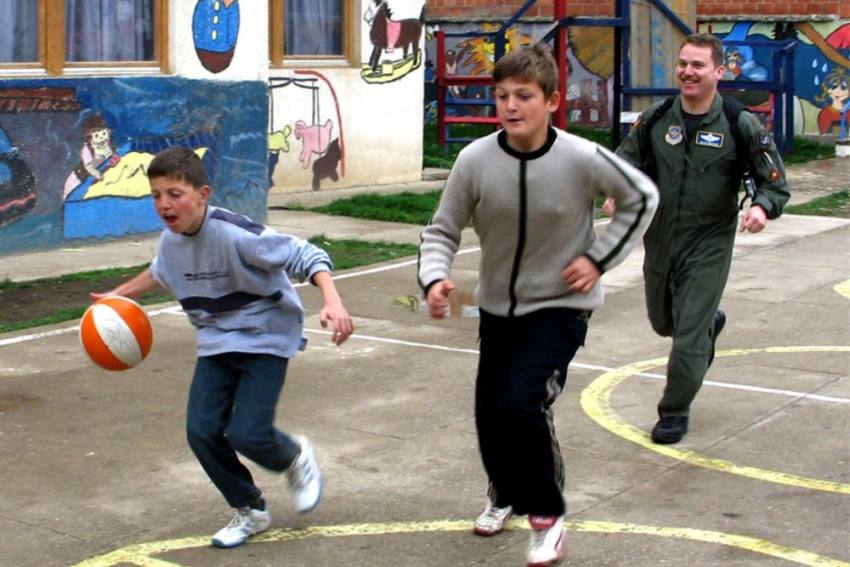
It is not for nothing that we have the often-used, cliché: All work and no play makes Jack a dull boy. Most of us agree, but when it comes to letting our children work out a sweat, we offer multiple excuses to stop them from taking up a sport—or any physical extra-curricular activity. Reason: Our priority is studies, rather than a game of football. But listen to the health experts. They say a balanced diet plus adequate exercise and sports help kids achieve optimum genetic growth and cognitive functions. Hence, sports should be made compulsory for children till they are 19 to help them realise their full potential of physical and mental growth. That underlines the close linkage between physical activities and nutrition.
“I strongly believe in healthy behaviour and part of it is good health, eating healthy food and, of course, engaging in sports as it is extremely important for many reasons. It’s good for the body and it’s good for your brain. It gives people a fresh mind,” says Henk Bekedam, the WHO representative to India. Speaking to Outlook Poshan on the sidelines of a conference on adolescent health, Bekedam recalls how as a youngster he played a lot of sports and “was eating a lot” too. “But there was nothing wrong with it because I was burning a lot of calories playing.”
Physical activities with good nutrition are two critical fundamentals for achieving optimum genetic height, say health experts. And you can go a bit extra because of trends seen every 10 years or every 20 years. If you have to achieve those trends and ultimate genetic potential, you need to continue to invest in physical activity, besides good nutrition. There’s no third element to it.
Thus, adolescence is a good time when children should become more aware about the need for healthy food and a balanced diet. At the same time, it is equally important to recognise that, at this moment, obesity is already one of the big challenges. People are eating too many unhealthy fatty foods and not getting adequate exercise.
Putting the focus on young people between 12 and 24, the World Development Report in 2007 had highlighted the importance of adolescence as a group for countries to invest in, and nurture, to ensure they can be productive members of communities. The World Bank’s report highlights that beyond early childhood, from gestation until five years, adolescence is the second-most sensitive period for human development, both for empowering youth and in terms of their contribution to society and economic growth.
Thinning and stunting are significant among adolescents, but unfortunately, it is not the focus of most national health and nutrition programmes. Thinning, anaemia and micronutrient deficiencies among adolescents can be checked through better nutrition, but if neglected, you will not be able to change the ultimate height and mental growth of youngsters.
Only appropriate nutrition and adequate physical activity can address this. The Japanese have been able to change the mean height of youngsters by introducing gymnastics in schools in the sixth or seventh standards, stresses Dr Sunil Mehra, executive director, MAMTA Health Institute for Mother and Child, Delhi. “Anaemia and stunting is common among girls and boys. So, somewhere we need to understand that nutrition around adolescents is a very, very poorly understood subject,” says Mehra, adding that there are improvements in the health of babies since we are focusing on newborn nutrition, under five and first 1,000 days.
Unfortunately, less investment has been made to acquire information and knowledge on adolescents. Therefore, national programmes at schools to incentivise enrolments through mid-day meals basically strive to address the nutrition position of younger children. But sports don’t get the deserved boost. Physical activity is a good indicator of achieving optimum genetic potential. But we’re still struggling with interventions for children between 10 and 19, particularly those around 10 to 14. All the interventions between 10 and 14 are critical as puberty is independent of your nutritional status, Mehra states.
The role of nutrition is about the whole body mass. It’s all about cognitive functions. It also has a bearing on scholastic performance. It has much to do with self-esteem and confidence, the pregnancy outcomes etc. So nutrition in adults is a missing link. We need to invest in this, states Dr Sangeeta Yadav, director professor, department of paediatrics, Maulana Azad Medical College, Delhi.
“Adolescence is the next major period of growth and development after childhood, where nutrition has to be more, both in terms of calories as well as protein for them to reach their optimum genetic growth potential,” Yadav says.
A focused attention on physical activities and healthy eating habits during this stage will also prevent a spectrum of illnesses associated with calcium and vitamin D deficiencies, anaemia, etc. Whatever you eat has to be accompanied by healthy lifestyles during adolescence, as it is the foundation which is going to support your body and take care of your health and nutrition till you are much older, stresses paediatrician Yadav.
Her advice to school mentors and parents is that it is important to be involved in games and other sporting activities at least till a child is 19 as it helps improve their body health, improves the release of growth hormones. Plus, exercise makes kids disciplined for mental health and helps them relax and enjoy life.
[“source=outlookindia”]

